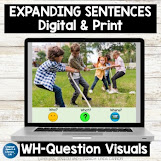Reasons to Celebrate 2020!
It wasn’t all bad, right?
There
is no denying that this year has been rough. The world has changed and
with it, many of us may have felt like we had to figure our jobs and lives out,
with every day bringing new challenges. Here are some ideas of truly
great accomplishments that we can celebrate as this historic year comes to an
end.
The
sheer quantity of new things you have learned
Not
since grad school has my brain been so full! Unlike grad school, this new
knowledge isn’t presented in a distraction-free classroom but instead is being
learned on the fly in busy living rooms and make-shift workspaces.
You
have learned new terminology, new technology, new platforms, and new
approaches. It has been overwhelming at times but by the end of 2020, it
is something to commemorate!
The
paradigm has shifted and you shifted with it
This
unchosen but necessary switch to distance learning, teletherapy, and hybrid
schedules has opened up new modes of working with students. Speech
sessions, paperwork, meetings - everything looks and feels different.
Yes, it’s been challenging, but your creativity has exploded.
You
have been flexible to change and are growing our therapy tool kit and you
should recognize this accomplishment.
(This
free download link takes you to a new Google Slide™ activity with real photos for expanding
sentences.)
The
depth of connections to students and families you have made
You
are virtually in your families’ homes, working with children and parents in new
ways. You are connecting with texts, videos, assignments on Seesaw - more
often and with more potential quality interactions than ever before. The
video feedback from students, the quick return text from a parent, the ability
for the SLP to model a chosen technique in a video model - all are at your
fingertips.
More
families connecting to speech resources and techniques is a win for you and
something for which you can commend yourself!
The
implementation of the always elusive “carry-over” activities
I
am guessing that Seesaw, Schoology, and Google Classroom are here to stay in
the life of an SLP. You have been forced to get comfortable using these
tools to advance your practice in a more inclusive way. These invaluable
resources can keep student’s learning from home even during a typical
year.
You
have learned how to improve student learning and results by including the home
learning environment. This feat alone is impressive enough to give
yourself a nice pat on the back.
(Here
is a link to a free PDF activity to keep those skills developing at home.)
New
skills in balancing life and work
Boundaries
have become even more important than ever, as work has seeped into our own
homes and it feels like we can work 24 hours a day and still not get everything
done.
You
have learned to take stretch breaks, set limits on working during evenings and
weekends, and you have learned just how valuable your personal time is.
Time-savers in therapy prep don’t just make your workday run more efficiently
but have become imperative to maintaining your sanity.
As
2021 approaches, you have learned what to take on and what you need to say no
to so that your life can continue to function. What a victory!
(Here
are links to a couple of my most downloaded Boom Cards of 2020.
These Boom Card decks are incredible time-savers and ready-to-go for
resources to use for multiple ages and skills in speech.)


This
year, the ground has been shaken from under us, yet we have accomplished more
than we may have realized and much more than this list includes.
Let’s look forward, not just hoping to return to how things once were but
let’s decide what invaluable practices we want to bring with us into
2021. Let’s celebrate and congratulate ourselves for all we have done!









